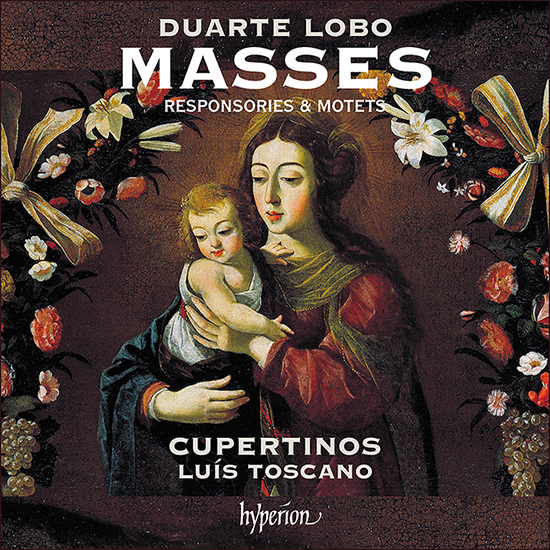Duarte Lobo: Masses, Responsories & Motets
Cupertinos, Lius Toscano
Hyperion CDA68306. 70’18

Duarte Lobo (c1565-1646) was one of the most prominent composers of the Portuguese Golden Age, gaining an international reputation during his lifetime. He is not to be confused with the Spanish Alonso Lobo (1555-1617). Early musical studies at Évora Cathedral led to posts as maestro di cappella at Évora Cathedrak, the Hospital Real de Todos-os-Santos, Lisbon, and at Lisbon Cathedral where he remained for nearly 50 years. This very welcome recording includes many premiere recordings of this remarkable composer in outstanding performances by Cupertinos, under Lius Toscano.
The programme is based aroud two complete Mass settings, the Missa Sancta Maria and the Missa Elisabeth Zachariae, both from Lobo’s 1621 Liber missarum. They are separated by a sequence of eight four-part Christmas Responsories from the 1602 collection Opuscula. The missing tenor part has been reconstucted by musicologist José Abreu, who also contributes to the comprehensive programme notes. The recording opens and closes with two motets, starting with Audivi vocem de caelo, his best known work, setting a text from the Book of Revelation and musically portraying a voice from heaven.
The two masses are parodies based on motets by the Spanish composer Francisco Guerrero. They demonstrate Lobo’s expertise at polyphonic writing and transformation of an existing source. The programme note described one of Lobo’s most ingenious uses of counterpoint when, in the second Agnus Dei of the Missa Sancta Maria, Lobo gives the initial motif followed by the phrase Per aliam viam reversi sunt (‘They returned to their land, following a different path’) an indication of a canon at the octave in retrograde. The recording concludes with the powerful 8-part polychoral Advent Marian antiphon Alma redemptoris mater.
The singers of Cupertinos make a extreemely impressive sound, aided by the generous acoustics of the Basilica do Bom Jesus in Braga, Portugal. They produce a crystal clear sound, the upper voices having an almost boy-like quality in their purity of tone and tonal stability. Director Lius Toscano allows the music to flow, unhindered by extraneous directorial mannerisms. He makes good use of the space of the Basilica, allowing the clarity of the voices to resonate with the acoustic. The recording quality is similarly impressive.
Further details, including a link to the booklet and a complete track listing can be found here. One interesting feature of this CD is the division into 66 separate tracks, several less than 30 seconds long. This is particularly helpful for those who want to study Lobo’s extraordinary musical talent by listing to short extracts, but does not affect other listener’s enjoyment.
